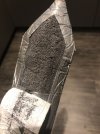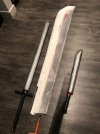Zombielarp
Newbie
Hello follow adventurers !
I am currently on a quest of creating the perfect weapons. I am trying to make them be as safe as possible while keeping them acceptably immersing. Attaching some images of swords I built (white short sword) and given by others (taped swords)
The white sword was made by me from 2lb Minicell foam (Cross Linked Polyethylene )sheets, with denser minicell foam around the core. I ordered from the foam factory, delivery took forever but the foam was decent in quality and quantity.
https://www.foambymail.com/XPE2/cross-linked-polyethylene-foam-2lb.html
The sword ended up looking pretty good after sanding and all but it still hits harder than I would like it to.
The long sword was not made by me, it is the sword my friend gave me, and that has served me in many a battle. And it was mostly fine impact absorption-wise, and I always thought it looked great.
The internet mostly recommends closed cell foam for these weapons, but I see my buddy has made the longsword from open celled foam - and it feels more shock absorbing than the closed cell. It could be (and is likely) that he used typical camping matt for this sword.
So here are my questions:
What is the ultimate safe & decent looking sword material ?
(I have spent upwards of $350 on foam orders so far and still did not find the right match. If references to what I have so far ordered will be helpful I will post those)
2) Additionally, what would be some of the top crafting tips you would give to a novice crafter keen on creating a safe and quality weapon ?
3) Link to recommended sources and materials will be appreciated !
note:
- I know that many don't recommend using duct tape to cover swords. But to be honest I never felt like it made the impact that much harder, while did I think it looked pretty cool. That said, I have already started looking into alternative finishing options such as Plastidip and simply using spray colors or cloth.
I am currently on a quest of creating the perfect weapons. I am trying to make them be as safe as possible while keeping them acceptably immersing. Attaching some images of swords I built (white short sword) and given by others (taped swords)
The white sword was made by me from 2lb Minicell foam (Cross Linked Polyethylene )sheets, with denser minicell foam around the core. I ordered from the foam factory, delivery took forever but the foam was decent in quality and quantity.
https://www.foambymail.com/XPE2/cross-linked-polyethylene-foam-2lb.html
The sword ended up looking pretty good after sanding and all but it still hits harder than I would like it to.
The long sword was not made by me, it is the sword my friend gave me, and that has served me in many a battle. And it was mostly fine impact absorption-wise, and I always thought it looked great.
The internet mostly recommends closed cell foam for these weapons, but I see my buddy has made the longsword from open celled foam - and it feels more shock absorbing than the closed cell. It could be (and is likely) that he used typical camping matt for this sword.
So here are my questions:
What is the ultimate safe & decent looking sword material ?
(I have spent upwards of $350 on foam orders so far and still did not find the right match. If references to what I have so far ordered will be helpful I will post those)
2) Additionally, what would be some of the top crafting tips you would give to a novice crafter keen on creating a safe and quality weapon ?
3) Link to recommended sources and materials will be appreciated !
note:
- I know that many don't recommend using duct tape to cover swords. But to be honest I never felt like it made the impact that much harder, while did I think it looked pretty cool. That said, I have already started looking into alternative finishing options such as Plastidip and simply using spray colors or cloth.


